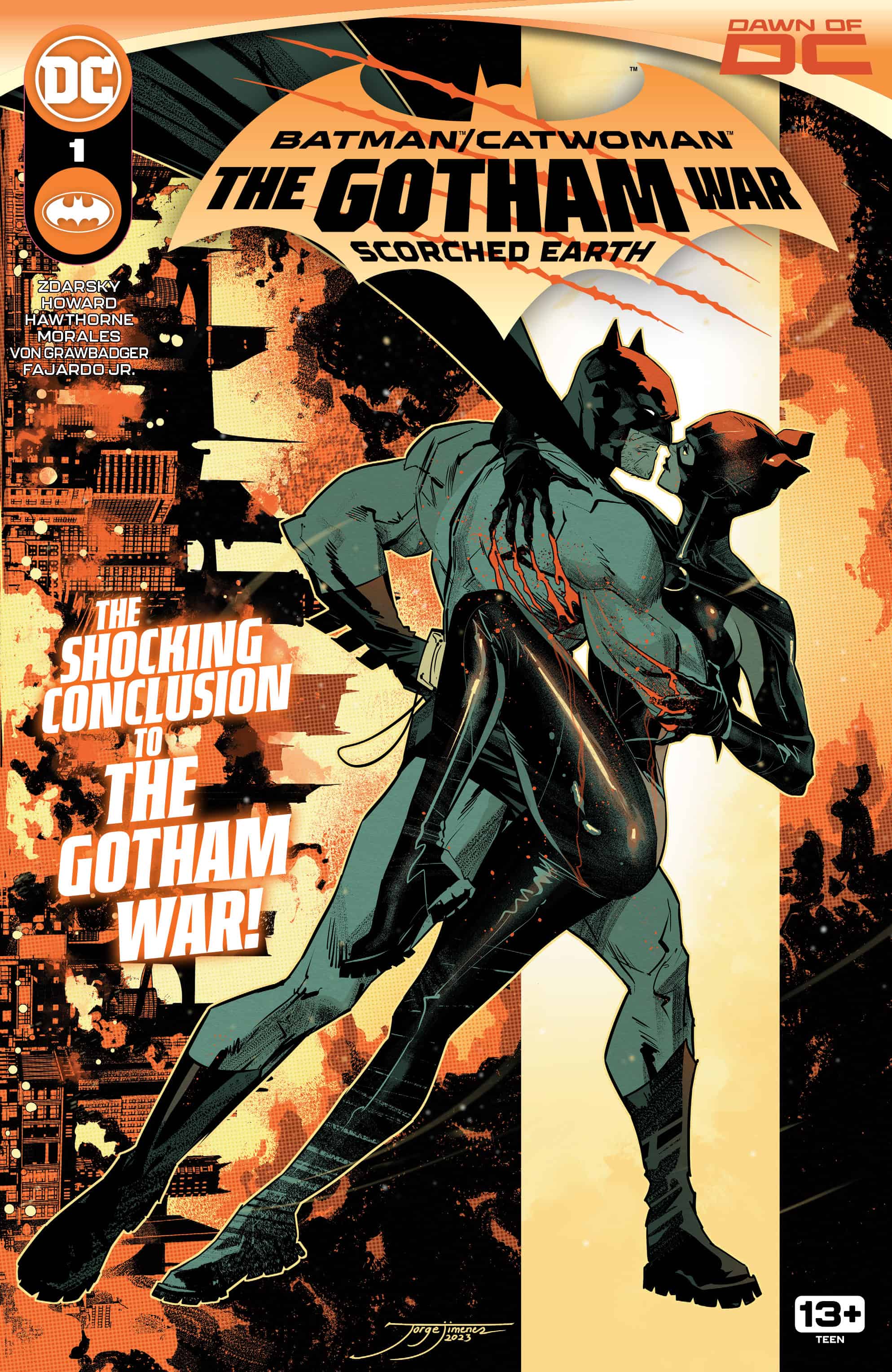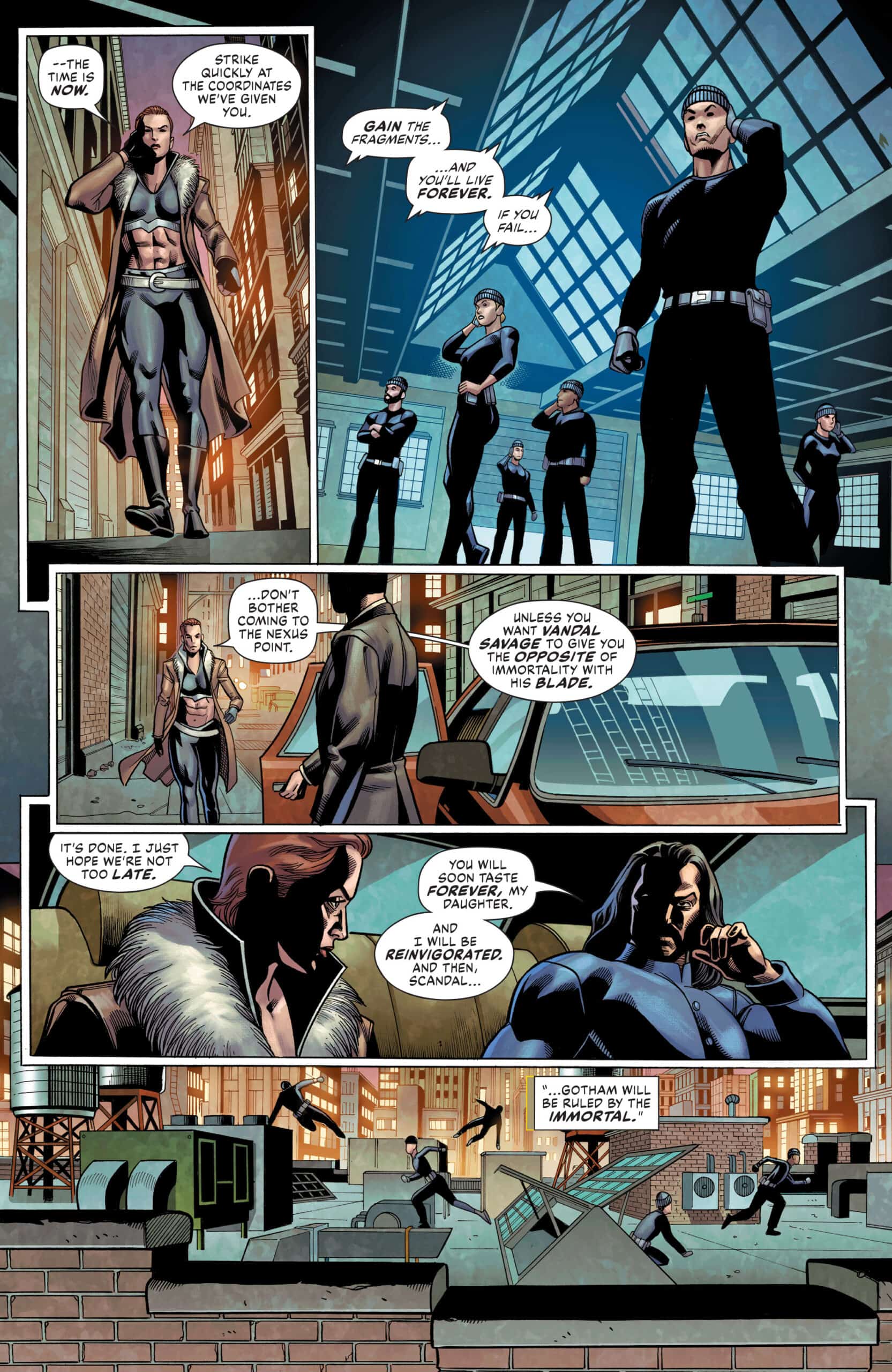Batman/Catwoman: The Gotham War - Scorched Earth #1

Recap
THE GOTHAM WAR ENDS HERE! The final chapter of this epic crossover is here, and Batman and his family must find a way to overcome the endgame of an ancient enemy! Can the Bat and the Cat set their differences aside? Is this the end of the Bat-Family? Lives change forever in this action-packed conclusion!
Review
Batman/Catwoman: The Gotham War – Scorched Earth #1 – written by Chip Zdarsky & Tini Howard with pencils by Mike Hawthorne & Nikola ?ižmešija, inks by Wade Von Grawbadger, Mark Morales, & ?ižmešija, colors by Arif Prianto, and lettering by Clayton Cowles – brings a conclusion to the Batfamily civil war as Vandal Savage strikes. The villain’s plan comes into a fuzzy focus, as he plans to use the meteor shards to attract a larger meteor that is set to collide with Gotham and bathe the survivors in immortality. Meanwhile, a cavalcade of battech-equipped rogues continues their attack on the city as Firefly sets off explosion after explosion.

The issue falls flat from page one, as it rapidly tries to make sense of the various plot elements that are being collided, instead coming off as a loose collection of beats. On the micro level, specifically at the character level, this crossover has worked while progressing various members of the Batfamily. The plot was at its strongest when it focused on advancing the separate stories of Batman and Catwoman and faltered when they collided throughout this crossover. With this issue, the separate stories converge into a mess of bad writing and left-field reversals that undercut the genuine menace and track laid before.
Vandal Savage’s immortality being tied to the Lazarus Pits and the Al Ghuls is an excellent twist, and Batman’s descent into madness has been a compelling undercurrent. In this issue, the first is taken a step too far with Savage trying to summon meteorites while the second fades into the background with minimal influence. This makes the book feel like it can’t commit to any one idea, instead sampling a multitude of possible stories and tones.
That instance of clashing tone and concept is never more evident than the reckless disregard of newly established status quos. It’s been less than five issues and the altered personality of Jason Todd is wasted in service of a flashy, yet empty beat. Selina Kyle’s plan for the henchmen of Gotham is over before it begins, and even her “demise” is reversed in less than ten pages. Nothing sticks or lingers in this moment, and proves the fleeting nature of changes in comics. Following the analogy of DC’s Civil War, this book speeds through the status quo of the Bendis era in fewer pages than a single standard issue.
Hawthorne’s art leaves a lot to be desired, especially since it comes off the heels of Jorge Jiménez, which was a similar issue to the opening issue of this crossover. The linework here comes off as stiff and flat, lacking any of the dynamism of the previous artwork from any of this creative team’s work. Instead, the book trades in faces that all look the same, boring action beats, and a lack of intensity that makes this artwork feel incongruent with everything else on the page.

Grawbadger and Morales’s inking do no favors for Hawthorne’s artwork, giving an unpolished quality to the artwork. The inking is inconsistent across the issue, making it difficult to tell characters apart while out of costume. Bruce, Dick, and Jason all look eerily similar, working to confirm the creepy theory that Bruce only adopts Robins that look just like himself. Other faces are just as inconsistent, with Vandal being another of the egregious figures in the issue. No polish or consistency in this book that sells it as a professional product, instead coming across as a loose collection of box checkings.
The shift in art is just as distracting, taking Hawthorne’s tense style and trading it for linework that is expressive and elastic but delivers bland reveals. A two-bit, no-nothing character makes a startling reveal, tying in the Red Hood two-parter like an afterthought. There’s no narrative weight behind the images that ?ižmešija brings to the page, and that manages to take the wind from the issue. The styles do not match at all, and actively clash in a way that resembles the conflicting narrative approaches in this issue. Pairing ?ižmešija with an artist like Jiménez or Leon would have been a better fit, with both styles hewing closer to the work on display at the end of this issue.
Final Thoughts
The Gotham War promises a bang but delivers a whimper with Batman/Catwoman: The Gotham War - Scorched Earth #1. The book struggles to tie together disparate plotlines that work at the moment but cannot create a cohesive story from start to finish. This is a crossover that works best when focusing on the small character work but consistently gets lost in the overarching plot. Similarly, the art flounders here, losing any sense of kinetic energy established in previous installments.
It, along with the inking and colors, feels rushed and makes the case for avoiding the larger crossover, instead proving that the standalone issues of Batman are the strongest issues of the event. Hopefully, both books can return to their creatively rich tales of complex characters and well-crafted plots now that the meteorite has wiped out this crossover.
Batman/Catwoman: The Gotham War – Scorched Earth #1: Status Quo Carousel
- Writing - 4/104/10
- Storyline - 5/105/10
- Art - 3/103/10
- Color - 3/103/10
- Cover Art - 8/108/10





